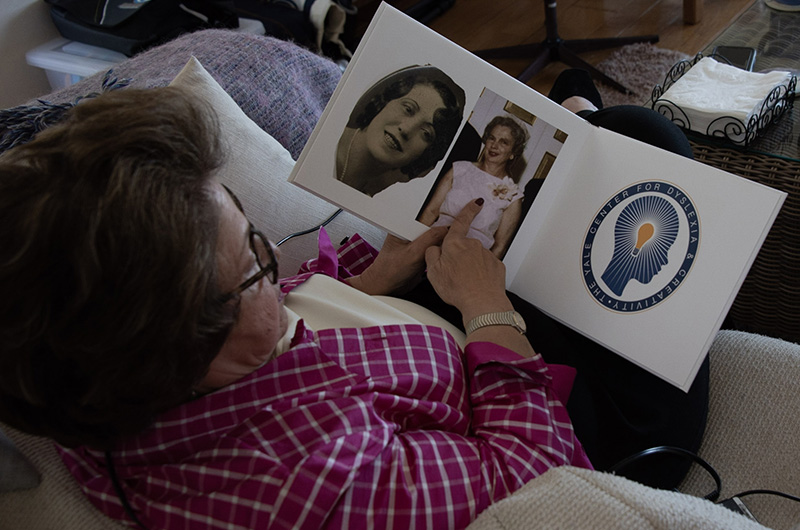Drs. Sally and Bennet Shaywitz are excellent at reading rooms. It’s generally the rest of the room that has trouble reading.
The couple, both proud summer Vineyarders and even prouder grandparents to their gaggle of grandchildren, run the Yale Center for Dyslexia and Creativity. For the past 35 years, they have devoted the majority of their professional careers to decoding the little-understood reading disorder that afflicts millions of people worldwide. It’s how they’ve met famous lawyers, doctors, politicians, journalists, actors, Saudi princesses — and still to this day, more than 50 Yale students every year who come to their Jack-and-Jill adjoining offices in New Haven. Every one of them is perfectly intelligent; every one of them struggles to read.
It’s the dichotomy that has defined their lives.
“We see everybody at Yale who could be dyslexic,” Dr. Shaywitz said from her sun-soaked living room on the town line between Oak Bluffs and Edgartown. This year, the couple was awarded the 2019 Genius Award from the Liberty Science Center. Although both have spent their lives studying dyslexia — and both credit the other with their achievements — it’s Mrs. Shaywitz who likes to do most of the talking.
She said: “Just recently, this man was referred to us, and we were going through his testing. He had a very high IQ, as well as being dyslexic. I called him and said, I just want to tell you, you’re dyslexic but you’re also very smart. He said, I think you got the wrong person. And I said, no, no, I’ve got the right person. And then there was a silence on the line, and I said, are you there? And he said yes, I’m crying. And I said, so am I. He’s 54 years old. He had spent his whole life thinking he was stupid.”
The Shaywitzes are not just diagnosticians and medical doctors, however. While he has headed pediatric neurology at Yale for 39 years, she has spent more than the last three decades following 445 children from kindergarten through twelfth grade as part of the Connecticut Longitudinal Study, an effort to further understand every element of dyslexia, from the brain systems involved in the disorder to the ways it can manifest itself — ways as varied and confusing as the permutations of the alphabet. They started the study in 1983. It remains ongoing.
“This will be the longest, most complete, continuous study of learning ever done,” Mrs. Shaywitz said. “And we’ll be able to see, because we took really great data from age five, and now at age 40, about outcomes.”
After growing up in the Bronx, Sally met Bennett at the Albert Einstein College of Medicine when both were in their twenties. Although both had visions of becoming doctors, neither had any idea that they would spend their lives studying dyslexia. In fact, few people really had any idea what dyslexia was.
“When we were in our training . . . I would ask my mentors, how do you diagnose these things?” Mr. Shaywitz said. “And they’d say, well, you have a child walk a balance beam. If they can’t walk a balance beam, they probably have dyslexia.”
“It’s crazy,” Mrs. Shaywitz added.
After he began working in Yale’s neurology department, she began to get calls because the school wanted to start a clinic for children who had learning problems.
“None of the guys wanted it because they thought it was beneath them,” Mrs. Shaywitz said. “So I didn’t take it right away, but I started working part-time. And I enjoyed it, but I was very much struck by seeing these cute, bright kids, and you see the parents, and all these parents are heartbroken because these children couldn’t read.”
That’s why Mrs. Shaywitz started the longitudinal study, and it’s why she decided to spend the rest of her professional life helping people understand the reasons that they struggled to read. While most people think that dyslexia involves the switching or reversal of letters, it is actually a difficulty in getting to and retrieving the smallest pieces of spoken language, called phonemes, from the brain. Consider the word “bat.” A typical reader thinks of the idea of a bat, and then accesses the word through the sounds “buh-aa-tuh.” But the dyslexic reader, who knows the word, can’t access the sounds.
“Speaking is automatic, but reading is not,” Mrs. Shaywitz said. “You have to be able to connect the print to something that is inherent . . . We’ve developed a model of dyslexia that says that it’s a weakness in decoding, getting to the sounds of words. But it’s surrounded by a sea of strengths. And that’s why dyslexic people have been Nobel laureates and achieved success in every single field.” Those strengths include reasoning, critical thinking, problem solving and comprehension. During their time at Yale, the Shaywitzes have helped everyone from Yale students to heart surgeons to octogenarians who come to their office thinking they are stupid, and leave knowing they are smart. They’ve visited John Irving at his home, worked with former head of the Cleveland Clinic Toby Cosgrove — who could replace a person’s heart but struggled to read their name — and list Jay Leno, Whoopi Goldberg and David Boies on their program’s website as other success stories.
One of the results of the longitudinal study was that one in five of the subjects had some form of dyslexia. But it also went deeper. Mrs. Shaywitz published a paper that demonstrated dyslexia affected both girls and boys, even though behavioral differences meant that it was hitherto underdiagnosed in girls. The study also showed that dyslexia was lifelong, and that even though a dyslexic person can improve their reading ability, they will always have the disorder. The Shaywitzes don’t think that’s a bad thing.
“Knowing that you’re dyslexic and all that it means is empowering,” Mrs. Shaywitz said. “It provides you with self-understanding and awareness. And that what you have has a name. Anxiety comes from the unknown, and when you know it has a name, you know what you need to do.”
Like many couples in their seventies, the Shaywitzes love to come to the Vineyard when they aren’t working. The trouble is, they almost always are. So sometimes they just bring their work with them.
“We’ve been coming for decades, and we just love it,” she said.
While on the Island, the couple has given talks on dyslexia at the West Tisbury Library, the Edgartown School and the Vineyard Center for Living. They’ve worked with librarians and come in the winter to observe teachers, finding that the Island’s educators were far better prepared to deal with dyslexic students than those in other small communities across the country.
“We were very impressed when we observed,” Mrs. Shaywitz said. “And we’ve interacted a lot because we feel like this is home.”
And anyone who is lucky enough to get to spend an afternoon with the Shaywitzes gets to discover that home, for them, means a lot more than physical space. It means a full spread of vegetables, cheeses, chips and crackers — and the opportunity to pack up the leftovers. It means stories of children who went on to Harvard Medical School and grandchildren who may also one day. And it means the genuine offer to test any friends or loved ones who might have dyslexia.
The first written description of dyslexia occurred in 1896, when a doctor in Sussex, England described a 14-year-old student named “Percy F.” as suffering from “congenital word blindness.” The doctor said that Percy had “always been a bright and intelligent boy . . . quick at games, and in no way inferior to others of his age. His great difficulty has been and is now his inability to learn to read.”
That brief description, according to Mrs. Shaywitz, summarizes the paradox that has confounded scientists for a century since — how otherwise intelligent people can struggle to read. Although the Shaywitzes are now in their seventies, they don’t plan to stop working to solve that puzzle any time soon.
“Why would we?” Mrs. Shaywitz said. “There’s so much work to do.”





Comments (5)
Comments
Comment policy »